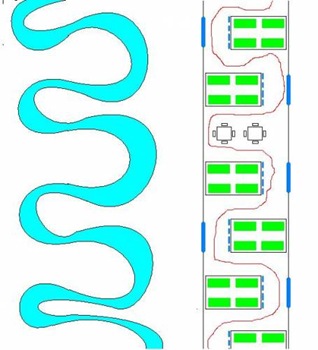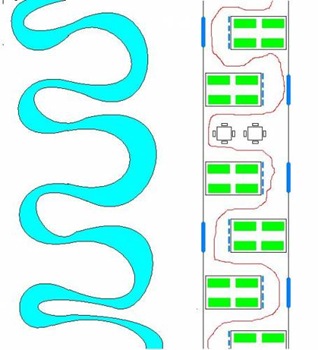向自然模式學習 - 合樸農學市集之綠園道篇

原文: 台灣樸門永續設計學會 理事長
孟磊 Peter Morehead
翻譯:Ema
上週末我有機會到台中市參加合樸農學市集,是個很棒且開心的體驗。過程中讓我見識到台灣的農夫市集的進展是這麼真切地持續發生中。我本人來自美國以農夫市集著名的威斯康辛州麥迪遜市,因此我見證過農夫市集所能締造驚人的社會、經濟、與健康的利處。
Last weekend I had a chance to check out the Hope Market 合樸農學市集 (http://www.hopemarket.com.tw/) in Taichung City. It was a great experience and heartening to see this progressive farmers market happening in Taiwan. I come from Madison, Wisconsin, a city famous for its farmers markets, so I have witnessed the awesome social, economic, and health benefits that farmers markets can create. I also used to co-manage Maplewood Gardens in Wisconsin, a very rural organic garden that depends on the weekly farmers market for a good portion of its income. For Maplewood Gardens’ head gardener David Peterson, the farmers market is also a vital social arena, giving him a chance to explain where and how his food is grown to interested customers. This is extremely important for David because he does a lot of work to care for the land and much of his work goes unnoticed amidst the Frito Lay potato farm desert that surrounds his garden oasis. I’m sure the gardeners in Taichung’s Hope Market are facing similar straits, and it is great to see their faces, hear their stories, and eat their food at the market!
上週末我有機會到台中市參加合樸農學市集,是個很棒且開心的體驗。過程中讓我見識到台灣的農夫市集的進展是這麼真切地持續發生中。我本人來自美國以農夫市集著名的威斯康辛州麥迪遜市,因此我見證過農夫市集所能締造驚人的社會、經濟、與健康的利處。
我曾合營美國威斯康辛州的楓木園圃(Maplewood Gardens),這個鄉村有機園圃就是有賴參與每週農夫市集所帶來收入為主要收入來源。對楓木花園的主要農友大衛.彼得森(David Peterson)而言,農夫市集誠為一個重要的社會場域,供他有機會向有興趣的消費者闡述作物生長的方式與地點。
尤其是他的農園被跨國企業樂氏洋芋片(Frito Lay)的超大農場所包圍,他關切土地與對自己農場所付的心力,雖然像是沙漠中的綠洲,卻因為只是小農沒有發聲的機會而致忽略,農夫市集提供機會讓他能闡述理念這點對大衛來說極為重要!
我確信台中合樸農學市集的農家們也正面臨著類似困境,故能在市集裡與他們面對面接觸,聆聽他們的故事與品嚐食作,真的很棒!

[Banners at the Hope Market introduce each participating grower and organization. Farmers markets are important places for people and farmers to connect.]
[飄揚在合樸農學市集的旗幟介紹著每位農家及其組織。農夫市集實為農家與人群能產生連結的重要場域]
One thing that I really like about the Hope Market is the recycling and reuse tent. For NT$10 people can hire dishes for the food and drinks served at the market. The utensils are then returned to the tent for washing. The tent also provides bins with clear instruction on recycling paper, cups, plastic and food waste. This is something that every market in Taiwan needs! In fact, it’s something that the market in my hometown needs.
我特別欣賞合樸農學市集的可回收與重複使用的帳棚!另外,市集還提供出租餐飲用的碗碟的服務,只消台幣10元租借費。租借的器皿在都可在棚內清理洗滌,另棚內也有對資源回收紙類、杯物、塑膠類與餐後剩餘物提供標示分明的回收箱。這真是台灣每個市集都需要的!事實上,這也是我自身家鄉裡市集所必要的!

Market-goers can rent a bowl from the reuse and recycling tent at the Hope Market]
[參與合樸農學市集的民眾可於回收處與棚內租借碗與餐具使用]
The other thing that really impressed me about the Hope Market was the way they utilize the natural pattern of a meander to slow down people and get them interested in more than just being consumers walking down the parkway. In permaculture, we regard the patterns of nature as a sort of language. We try to learn this language and adopt natural patterns in everything we design because each pattern tells us how energy flows. Energy can be in the form of water, wind, and everything animate and inanimate. The meander is a natural pattern all about slowing down. It occurs at the end of rivers on very flat lands where the water meanders slowly toward the ocean. The most action occurs at the outer edge of the bows, where the water flow is fastest. This is where water cuts away at the shore and extends the bows farther away. The inner edge of the bows is where sedimentation occurs. This meander shape constantly changes but very slowly. This is the last place for river water to sink into groundwater and for groundwater to surface before going to sea. It is also a very fertile place as the silt and nutrients brought down by the river are slowed down to create shoreline. The fertility of meandering rivers is reflected by the huge biodiversity that can be supported in these areas. The meander pattern also appears in your intestines, which slow down the rate that food passes through your body, so that more nutrients can be extracted. Some gardeners, like Huang Shenglin (黃盛璘) in Sansia, use the meander pattern in their gardens to slow down water and increase the chance of nutrients staying rather than washing away to the ocean.
另一讓我印象深刻的則是市集利用似河天然蜿蜒圖紋構建出放緩人群腳步的動線,興之所趨的群眾即可多面向瀏覽,不需只當個迅速通行園道的消費者。
在樸門永續設計(Permaculture)裡,我們視自然圖紋為某種語言,我們試著學習這種語言並將之納入我們每樣設計裡,因每一種自然圖紋都訴說著能量的流動。能量可以水和風的型式呈現,動靜皆可。
河蜿曲折的天然圖紋和放緩速度極其相關,狀態就與平淺陸地的下游當河水迎向海洋末端時雷同。水勢最湍急處常位於河流內灣道離心處,此處亦是流水沖刷與形塑著河岸主力點。沉積作用發生於河道內灣部。河蜿帶的形狀儘管緩慢卻不間斷地改變著。此區是河水流向海洋前滲入土壤轉變為地下水之最終處,堆積的淤泥和養分肥沃此區並也點滴形塑著海岸線。這裡的生物多樣性在在反映出淤泥肥沃的滋養力。似河蜿蜒的圖紋也存在於人體腸內,食物在經過腸道時可藉緩慢地蠕動多被吸收。
某些農家,像Sansia的黃盛璘就在他的園圃中使用河蜿的圖紋動線設計出能減緩水速、保有更多留住水中養分的機會

[The Hope Market mimics the meandering pattern of a slow river to its advantage.]
[合樸農學市集倣效似河蜿蜒的天然動線,並藉此設計以達最大使用效益]
It only makes sense that the meander pattern was adopted by the Hope Market. They could have chosen to put market stalls on either side of the parkway to let people go by faster, but this would be counterproductive to their purpose. As founder Mengkai (孟凱) says, the Hope Market is all about slowing down the fast pace of modern culture and getting people back into healthy eating, healthy growing and healthy living. The design of their market reflects these values and it really works! The meandering market increases the time one has to spend going through the market, and increases the chances that your mind will, like silt in a slow river, be able to slow down and focus on one thing at a time. This is important to the independent organic growers who depend on the market for income, and perhaps more importantly, for recognition that they are doing something different from mainstream growers that is good for the environment and society. Each tent has four farmers or organizations and a description is written about them and appropriately located at the sedimentation point on the inside of each meander.
合樸農學市集會想得到要採用河蜿動線並不令人訝異!市集大可選用佇列於園道兩旁(排排站)的亭棚以加快群眾通行的腳步,不過這樣一來,便會與合樸原意相違背了。
誠如合樸創辦人孟凱所言,合樸農學市集的運作理念在於放緩現代人的生活步調,使人們重返好好吃飯、好好成長與好好生活的題旨。市集的運作在在都反映出這些核心價值確實行得通!似河蜿蜒的市集增加了每一個人通行園道的時間,故也增加了人們放緩腦筋轉速、使思緒可如淤泥般在單一時間裡沉澱、聚焦於單一事物的可能性。
這樣的運作方式對仰類市集收入過生活的有機小農來說實為重要,甚至他們能掙得人們對於他們裨益環境與社會的存在認同,這些都是有別於主流農家的。每個亭帳裡安置四戶農家或組織,在每區河蜿動線的內側匯集點皆有其介紹。

[The meander pattern slows this bustling market down to a friendlier pace.]
[河蜿帶的動線設置使熙攘的市集緩蛻為較友善的步調]
Although it’s not very large, I think it would be easy to spend a half a day at this market. All the physical and social sustenance you could need for the day can be obtained here, and they even have a storage tent to put your stuff while walking around. It’s a great place to run into like-minded people, but it’s also centrally located in a way that many people of all walks of life are bound to walk through and be exposed to this sector of society. So if you happen to be in Taichung City on the second Saturday of the month, definitely check out the Hope Market. Support the farmers and volunteers who make the market happen while creating a wonderful atmosphere of good vibrations. I hope the market keeps growing to fill the entire parkway someday and I think it’s very possible that it will!
雖然市集場地不大,但是可以輕易的消磨大半天的時間在市集閑晃。所有身體上與社會層次的每日所需品皆可在市集取得,市集還設有個亭棚供民眾託放物品。這是個很棒的場域,人們可以在這裡巧遇志趣相投的朋友。同時這裡也位於生活機能中心點,是都會裡群眾必經交界處。所以,假使碰巧你在每個月份的第二個星期六造訪台中,你可務必要探訪合樸農學市集一遭。支持那些讓市集得以實現的農夫與志工,感受心靈共振的氛圍。期許合樸農學市集將來能充滿整個綠園道,而我期望,一定會有這麼一天的!
